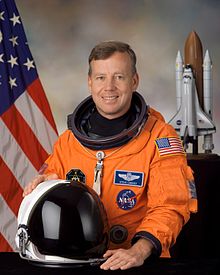Steven Lindsey
| Steven Lindsey | |
|---|---|
 | |
| NASA Astronaut Chef | |
| Statsborger | USA |
| Nationalitet | Amerikaner |
| Status | Chef for NASA's astronautkorps |
| Født | 24. august 1960 Arcadia, Californien |
Andet arbejde | Jagerpilot |
| Uddannelses- sted | United States Air Force Academy U.S. Air Force Test Pilot School |
| Rang | Oberst, USAF |
Tid i rummet | 50d 03t 29min |
| Udvælgelse | Nasa-gruppen fra 1994 |
| Mission(er) | STS-87, STS-95 , STS-104, STS-121 STS-133 |
| Missionsemblemer | |
Steven Wayne Lindsey (født 24. august 1960 i Arcadia, Californien) Han er NASA-astronaut og fra 2006 til 2009 var han chef for NASA's astronautkorps. Lindsey har fløjet fire gange, og er i gang med den femte rumfærge-mission.
Eksterne henvisninger
| Spire Denne artikel om rumfart er en spire som bør udbygges. Du er velkommen til at hjælpe Wikipedia ved at udvide den. |
Medier brugt på denne side
A drawing of NASA's Space Shuttle Challenger. Image provided by Dryden Flight Research Center at Edwards Air Force Base, California. See [1], specifically EG-0076-04.eps.
The STS-87 patch is shaped like a space helmet symbolizing the Extravehicular Activity (EVA) on the mission in support of testing of tools for the assembly of the International Space Station (ISS). Earth is shown reflected on the backside of the helmet. The Space Shuttle Columbia forms the interface between the Earth and the heavens, the back and front sides of the helmet in profile. The three red lines emerging from Columbia represent the astronaut symbol as well as the robot arm, which was used to deploy and retrieve the Spartan satellite.
The text 'µg' represents the payloads studying microgravity science in space on this United States Microgravity Payload (USMP-4) mission. Gold flames outlining the helmet visor represent the corona of the Sun, which will be studied by Spartan. The flag of Ukraine is next to the name of the payload specialist who is the first person from that nation to fly on the Space Shuttle.
STS-104, International Space Station (ISS) assembly mission 7A, marks the completion of the initial assembly phase of ISS. The 7A crew will install, activate, and perform the first space walk from the Joint Airlock. The Joint Airlock will enable crews to perform space walks in either United States or Russian spacesuits while recovering over 90 percent of the gases that were previously lost when airlocks were vented to the vacuum of space. This patch depicts the launch of Space Shuttle Atlantis and the successful completion of the mission objectives as signified by the view of the ISS with the airlock installed. The astronaut symbol is displayed behind Atlantis as a tribute to the many crews that have flown before. The hard work, dedication, and teamwork of the airlock team is represented by the ISS components inside the payload bay which include the Joint Airlock and four high pressure gas tanks containing nitrogen and oxygen. In the words of a STS-104 crew spokesperson, "The stars and stripes background is symbolic of the commitment of a nation to this challenging international endeavor and to our children who represent its future."
The STS-95 patch, designed by the crew, is intended to reflect the scientific, engineering, and historic elements of the mission. The Space Shuttle Discovery is shown rising over the sunlit Earth limb, representing the global benefits of the mission science and the solar science objectives of the Spartan Satellite. The bold number '7' signifies the seven members of Discovery's crew and also represents a historical link to the original seven Mercury astronauts. The STS-95 crew member John Glenn's first orbital flight is represnted by the Friendship 7 capsule. The rocket plumes symbolize the three major fields of science represented by the mission payloads: microgravity material science, medical research for humans on Earth and in space, and astronomy.
The STS-133 mission patch is based upon sketches from the late artist Robert McCall; they were the final creations of his long and prodigious career. In the foreground, a solitary orbiter ascends into a dark blue sky above a roiling fiery plume. A spray of stars surrounds the orbiter and a top lit crescent forms the background behind the ascent. The mission number, STS-133, is emblazoned on the patch center, and crewmembers' names are listed on a sky-blue border around the scene. The Shuttle Discovery is depicted ascending on a plume of flame as if it is just beginning a mission. However it is just the orbiter, without boosters or an external tank, as it would be at mission's end. This is to signify Discovery's completion of its operational life and the beginning of its new role as a symbol of NASA's and the nation's proud legacy in human spaceflight.
The STS-121 patch depicts the Space Shuttle docked with the International Space Station (ISS) in the foreground, overlaying the astronaut symbol with three gold columns and a gold star. The ISS is shown in the configuration that it will be in during the STS-121 mission. The background shows the nighttime Earth with a dawn breaking over the horizon. STS-121, ISS mission ULF1.1, is the final Shuttle Return to Flight test mission. This utilization and logistics flight will bring a multipurpose logistics module (MPLM) to the ISS with several thousand pounds of new supplies and experiments. In addition, some new orbital replacement units (ORUs) will be delivered and stowed externally on ISS on a special pallet. These ORUs are spares for critical machinery located on the outside of the ISS. During this mission the crew will also carry out testing of Shuttle inspection and repair hardware, as well as evaluate operational techniques and concepts for conducting on-orbit inspection and repair.
Astronaut Steven W. Lindsey, commander.







